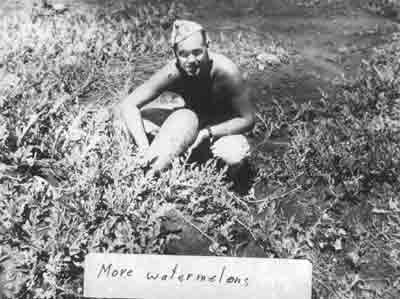
Abandoned AA defenses

Wrecked Zero

Upside down Zero

William Sable in Corn Field

G.I. Cooks

Sabel with Watermellon

Sable with tomatos

Loading watermellon crop
|
Farming Background
I was a poultry farmer prior to my induction
into the army in April 1941 and enjoyed gardening. When I saw the
rich dark soil in the cocoa bean plantation where our regiment was
bivouacked, I wondered if flowers and vegetables would grow here
in the tropics. In my weekly airmail letters home to my folks, I
requested a few seeds be included in each return letter. The next
letter contained radish, lettuce, tomato, cucumber and zinnia seeds.
It wasn't long before I had a small flower and garden patch growing
along side my quarters. I remember the zinnias would grow into huge
shrubs in that hot, humid, tropical climate, as there was no frost
to curtail their growth. The flowers would continuously bloom and
the seeds would fall down into the moist fertile soil and start
growing again. I can only assume that my zinnias are still growing
on a few of the tropical islands in the South Pacific.
Munda
After nine months on Santos, our battalion
was ordered to Munda in the Solomons and we arrived a couple of
months after the Americans had fought a terrific battle and recaptured
the island from the Japanese. When my platoon was building the commanding
general's mess hall, I noticed him puttering around a small garden
along side his quarters. In the course of our conversation, I mentioned
the garden I had on Santos and how successful it was. When the vegetable
farm project on Kolombangara was being contemplated, he remembered
my interest and spoke to our colonel about it and who, in turn,
asked me if I would be interested in running the operation. The
fresh produce was to be sent back to the base hospital to augment
the drab, dehydrated menu that the wounded men were served during
their recuperation. Needless to say, they were much appreciated
by the patients in the hospital after the farm became operative.
Kolombangara
I accepted the challenge and with 5 enlisted
men whom had previous agricultural experience and a landing craft
borrowed from the navy, we set out for Kolombangara Island 5 miles
away, in January 1944. The British furnished 16 male natives to
help on the farm. Through the Red Cross, a variety of seeds were
obtained from Australia and New Zealand including watermelon, muskmelon,
okra, tomatoes, lettuce, beets, radishes and a bushel of field corn
that made good roasting ears when mature. From our outfit I was
able to procure a small caterpillar tractor as well as a single
bottom plow.
Our mission was to farm Vila Airfield, the old abandoned airdrome
that the Japanese had carved out of the pre-war coconut plantation
when they took over the island in their bid to dominate the world.
The trees on the plantation had been planted in a checkerboard pattern
about twenty feet apart each way. To hastily construct the airfield,
the Japanese cut the trees flush with the ground. When we tried
to plow, we would hit the buried stumps and ruin the plow. We found
it best to farm a narrow 10-foot strip between the decaying stumps.
Solomon Islanders Help
When the native helpers first arrived,
I asked one of the educated men how to say, "Don't plant the
seeds too close." He rattled off something that I couldn't
understand and I told him he better write it down. He wrote, "
Lopu lete va soku." The natives would get quite a kick out
of me trying to speak their language and they would giggle like
little kids when I tried to converse with them in their native tongue.
The natives had never tasted watermelons before
and enjoyed eating the fresh watermelons as much as we did. I instructed
them how to dry the seeds and replant them in their home gardens.
For the past fifty-five years I have been wondering if the natives
on the island of Kolombangara are still planting and relishing the
watermelons I introduced to the island some 55 years ago.
Return to William Sable Main
Page |
|







